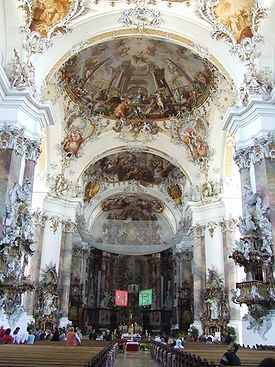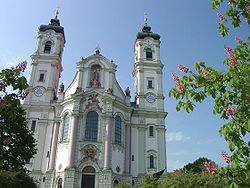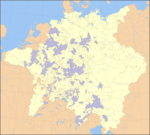- Ottobeuren Abbey
-
Imperial Abbey of Ottobeuren
Reichskloster OttobeurenImperial Abbey of the Holy Roman Empire ← 
←
1299–1624
1710–1803 →
→
 →
→Coat of arms
The façade of the basilica, designed by Johann Michael Fischer, has been hailed as a pinnacle of Bavarian Baroque architecture Capital Ottobeuren Abbey Government Principality Historical era Middle Ages - Founded 764 - Imperial immediacy 1299 - Lost Reichsfreiheit as
Vogtei of Augsburg
1624- Regained immediacy 1710 - Secularised to Bavaria 1803 Ottobeuren is a Benedictine abbey, located in Ottobeuren, near Memmingen in the Bavarian Allgäu, Germany.
Contents
First foundation
It was founded in 764 by Blessed Toto, and dedicated to St. Alexander, the martyr. Of its early history little is known beyond the fact that Toto, its first abbot, died about 815 and that Saint Ulrich was its abbot in 972. In the 11th century its discipline was on the decline, until Abbot Adalhalm (1082–94) introduced the Hirsau Reform. The same abbot began to restore the decaying buildings, which were completed, with the addition of a convent for noble ladies, by his successor, Abbot Rupert I (1102–45). Under the rule of the latter the newly founded Marienberg Abbey was recruited with monks from Ottobeuren. His successor, Abbot Isengrim (1145–80), wrote Annales minores [1] and Annales majores.[2]
Blessed Conrad of Ottobeuren was abbot from 1193 until his death in 1227, described by the Benedictines as a "lover of the brethren and of the poor" [1].
In 1153, and again in 1217, the abbey was consumed by fire. In the 14th and 15th centuries it declined so completely that at the accession of Abbot Johann Schedler (1416–43) only six or eight monks were left, and its annual revenues did not exceed 46 silver marks. Under Abbot Leonard Wiedemann (1508–46) it again began to flourish: he erected a printing establishment and a common house of studies for the Swabian Benedictines. The latter, however, was soon closed, owing to the ravages of the Thirty Years' War.
Ottobeuren became an imperial abbey in 1299, but lost this status after the Prince-Bishop of Augsburg had become Vogt of the abbey. These rights were renounced after a court case at the Reichskammergericht in 1624. In 1710 the abbey regained its status as an imperial abbey, but did not become a member of the Swabian Circle.
The most flourishing period in the history of Ottobeuren began with the accession of Abbot Rupert Ness (1710–40) and lasted until its secularization in 1802. From 1711-1725 Abbot Rupert erected the present monastery, the architectural grandeur of which has merited for it the name of "the Swabian Escorial". In 1737 he also began the building of the present church, completed by his successor, Anselm Erb, in 1766. In 1803 Ottobeuren became part of Bavaria. At that time the territory had about 12,000 inhabitants and an area of some 165 km2 (64 sq mi).
Second foundation
In 1834 King Louis I of Bavaria restored it as a Benedictine priory, dependent on St. Stephen's Abbey, Augsburg. It was granted the status of an independent abbey in 1918.
As of 1910, the community consisted of five fathers, sixteen lay brothers, and one lay novice, who had under their charge the parish of Ottobeuren, a district school, and an industrial school for poor boys.
 Rococo interior of the basilica
Rococo interior of the basilica
Ottobeuren has been a member of the Bavarian Congregation of the Benedictine Confederation since 1893.
Monks of Ottobeuren
Noteworthy among monks of Ottobeuren are:
- Nicolas Ellenbog, humanist, d. 1543
- Jacob Molitor, the learned and saintly prior, d. 1675
- Albert Krey, the hagiographer, d. 1713
- Fr. Schmier, canonist, d. 1728
- Augustine Bayrhamer, d. 1782 historian
- Maurus Feyerabend, d. 1818, historian
- Abbot Honoratus Goehl (1767–1802), a promoter of true church music, and founder of two schools
- Ulric Schiegg, the mathematician and astronomer, d. 1810.
Music
Ottobeuren Abbey has one of the richest music programs in Bavaria, with concerts every Saturday. Most concerts feature one or more of the Abbey's famous organs. The old organ, the masterpiece of French organbuilder Karl Joseph Riepp (1710–75), is actually a double organ; it is one of the most treasured historic organs in Europe. It was the main instrument for 200 years, until 1957 when a third organ was added by G. F. Steinmeyer & Co, renovated and augmented in 2002 by Johannes Klais, making 100 stops available on five manuals (or keyboards).
Notes
- ^ Monumenta Germaniae Historica: Scriptores, XVII, 315 sq.
- ^ ibid., 312 sq.
References
 This article incorporates text from a publication now in the public domain: Herbermann, Charles, ed (1913). "Ottobeuren". Catholic Encyclopedia. Robert Appleton Company.
This article incorporates text from a publication now in the public domain: Herbermann, Charles, ed (1913). "Ottobeuren". Catholic Encyclopedia. Robert Appleton Company. "Ottobeuren". Catholic Encyclopedia. New York: Robert Appleton Company. 1913.
"Ottobeuren". Catholic Encyclopedia. New York: Robert Appleton Company. 1913.- Schleglmann, 1906. Geschichte der Säkularisation im rechtsrheinischen Bayern, vol. III, pp. 611–54. Regensburg.
External links
 Media related to Basilika Ottobeuren at Wikimedia Commons
Media related to Basilika Ottobeuren at Wikimedia Commons- (German) Ottobeuren Abbey website
Images
See also
 Holy Roman Empire — Imperial abbeys of the Swabian College
Holy Roman Empire — Imperial abbeys of the Swabian CollegeImperial abbeys and colleges
(Reichsabteien, Reichsklöster
und Reichsstifte)Baindt • Comburg • Disentis • Elchingen • Frauenchiemsee • Fraumünster • Fürstenfeld • Gengenbach • Göss • Gutenzell • Heggbach • Helmarshausen • Herrenalb • Irsee • Kaisheim† • Lindau • Lorsch • Marchtal • Marmoutier • Maulbronn • Mönchrot • Mondsee • Murbach* • Neresheim • Ochsenhausen • Ottobeuren • Petershausen • Prüfening • Reichenau • Roggenburg • Rottenmünster • St. Gall's* • St. George's in Isny • Salem • Schänis • Schussenried • Schuttern • Söflingen • Ursberg • Waldsassen • Weingarten • Weissenau • WettenhausenImperial charterhouse
(Reichskartause)* Also a Prince of the Empire † Also in Rhenish College Coordinates: 47°56′29″N 10°17′53″E / 47.94139°N 10.29806°E
Categories:- Imperial abbeys
- Former principalities
- Former countries in Europe
- States of the Holy Roman Empire
- States and territories established in 1299
- States and territories disestablished in 1803
- Monasteries in Bavaria
- Benedictine monasteries in Germany
- Carolingian architecture
- 764 establishments
- Christian monasteries established in the 8th century
- 1624 disestablishments
- States and territories established in 1710
- Basilica churches in Germany
Wikimedia Foundation. 2010.













